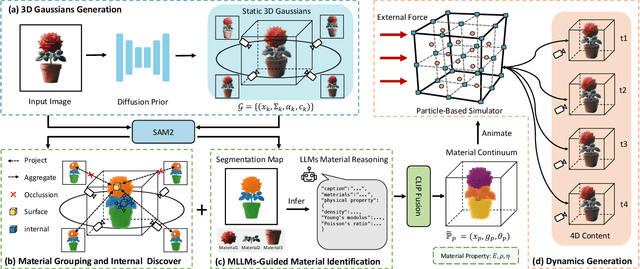Jiajing Lin
Fading the Digital Ink: A Universal Black-Box Attack Framework for 3DGS Watermarking Systems
Aug 10, 2025Abstract:With the rise of 3D Gaussian Splatting (3DGS), a variety of digital watermarking techniques, embedding either 1D bitstreams or 2D images, are used for copyright protection. However, the robustness of these watermarking techniques against potential attacks remains underexplored. This paper introduces the first universal black-box attack framework, the Group-based Multi-objective Evolutionary Attack (GMEA), designed to challenge these watermarking systems. We formulate the attack as a large-scale multi-objective optimization problem, balancing watermark removal with visual quality. In a black-box setting, we introduce an indirect objective function that blinds the watermark detector by minimizing the standard deviation of features extracted by a convolutional network, thus rendering the feature maps uninformative. To manage the vast search space of 3DGS models, we employ a group-based optimization strategy to partition the model into multiple, independent sub-optimization problems. Experiments demonstrate that our framework effectively removes both 1D and 2D watermarks from mainstream 3DGS watermarking methods while maintaining high visual fidelity. This work reveals critical vulnerabilities in existing 3DGS copyright protection schemes and calls for the development of more robust watermarking systems.
Enhancing Large-scale UAV Route Planing with Global and Local Features via Reinforcement Graph Fusion
Dec 20, 2024Abstract:Numerous remarkable advancements have been made in accuracy, speed, and parallelism for solving the Unmanned Aerial Vehicle Route Planing (UAVRP). However, existing UAVRP solvers face challenges when attempting to scale effectively and efficiently for larger instances. In this paper, we present a generalization framework that enables current UAVRP solvers to robustly extend their capabilities to larger instances, accommodating up to 10,000 points, using widely recognized test sets. The UAVRP under a large number of patrol points is a typical large-scale TSP problem.Our proposed framework comprises three distinct steps. Firstly, we employ Delaunay triangulation to extract subgraphs from large instances while preserving global features. Secondly, we utilize an embedded TSP solver to obtain sub-results, followed by graph fusion. Finally, we implement a decoding strategy customizable to the user's requirements, resulting in high-quality solutions, complemented by a warming-up process for the heatmap. To demonstrate the flexibility of our approach, we integrate two representative TSP solvers into our framework and conduct a comprehensive comparative analysis against existing algorithms using large TSP benchmark datasets. The results unequivocally demonstrate that our framework efficiently scales existing TSP solvers to handle large instances and consistently outperforms state-of-the-art (SOTA) methods. Furthermore, since our proposed framework does not necessitate additional training or fine-tuning, we believe that its generality can significantly advance research on end-to-end UAVRP solvers, enabling the application of a broader range of methods to real-world scenarios.
Phys4DGen: A Physics-Driven Framework for Controllable and Efficient 4D Content Generation from a Single Image
Nov 25, 2024



Abstract:The task of 4D content generation involves creating dynamic 3D models that evolve over time in response to specific input conditions, such as images. Existing methods rely heavily on pre-trained video diffusion models to guide 4D content dynamics, but these approaches often fail to capture essential physical principles, as video diffusion models lack a robust understanding of real-world physics. Moreover, these models face challenges in providing fine-grained control over dynamics and exhibit high computational costs. In this work, we propose Phys4DGen, a novel, high-efficiency framework that generates physics-compliant 4D content from a single image with enhanced control capabilities. Our approach uniquely integrates physical simulations into the 4D generation pipeline, ensuring adherence to fundamental physical laws. Inspired by the human ability to infer physical properties visually, we introduce a Physical Perception Module (PPM) that discerns the material properties and structural components of the 3D object from the input image, facilitating accurate downstream simulations. Phys4DGen significantly accelerates the 4D generation process by eliminating iterative optimization steps in the dynamics modeling phase. It allows users to intuitively control the movement speed and direction of generated 4D content by adjusting external forces, achieving finely tunable, physically plausible animations. Extensive evaluations show that Phys4DGen outperforms existing methods in both inference speed and physical realism, producing high-quality, controllable 4D content.
Phy124: Fast Physics-Driven 4D Content Generation from a Single Image
Sep 11, 2024Abstract:4D content generation focuses on creating dynamic 3D objects that change over time. Existing methods primarily rely on pre-trained video diffusion models, utilizing sampling processes or reference videos. However, these approaches face significant challenges. Firstly, the generated 4D content often fails to adhere to real-world physics since video diffusion models do not incorporate physical priors. Secondly, the extensive sampling process and the large number of parameters in diffusion models result in exceedingly time-consuming generation processes. To address these issues, we introduce Phy124, a novel, fast, and physics-driven method for controllable 4D content generation from a single image. Phy124 integrates physical simulation directly into the 4D generation process, ensuring that the resulting 4D content adheres to natural physical laws. Phy124 also eliminates the use of diffusion models during the 4D dynamics generation phase, significantly speeding up the process. Phy124 allows for the control of 4D dynamics, including movement speed and direction, by manipulating external forces. Extensive experiments demonstrate that Phy124 generates high-fidelity 4D content with significantly reduced inference times, achieving stateof-the-art performance. The code and generated 4D content are available at the provided link: https://anonymous.4open.science/r/BBF2/.
 Add to Chrome
Add to Chrome Add to Firefox
Add to Firefox Add to Edge
Add to Edge